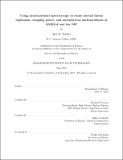Using fusion-product spectroscopy to study inertial fusion implosions, stopping power, and astrophysical nucleosynthesis at OMEGA and the NIF
Author(s)
Zylstra, Alex B
DownloadFull printable version (45.35Mb)
Other Contributors
Massachusetts Institute of Technology. Department of Physics.
Advisor
Richard Petrasso.
Terms of use
Metadata
Show full item recordAbstract
By measuring energetic charged-particle products from fusion reactions occurring in plasmas, nuclear diagnostics can be used to study the properties of the burning plasma, as a probe of the plasma, or of the fundamental fusion reaction physics. In this thesis, fusion product spectroscopy is used to study ignition-scale inertial fusion implosions, measure charged-particle stopping in dense plasmas to high accuracy, and study reactions relevant to nuclear astrophysics. 'Surrogate' plastic-shell implosions at the National Ignition Facility with D³He fuel produce 14.7-MeV protons. Spectrometry capability developed for the NIF has been used to study these protons produced at the 'shock' burn in these implosions, which proceeds the main 'compression' burn by several hundred picoseconds (ps). A 1-D implosion model was developed to interpret the spectra of the emitted shock-produced protons. Higher areal densities ([rho]R) are observed for implosions where the laser is kept on for a longer duration ('no-coast'); combining these data with x-ray radiography reveals that the shock-bang time occurs anomalously late in these implosions relative to hydrodynamic simulations. By using multiple detectors, low-mode (~2) implosion asymmetries are measured. When compared to stagnation x-ray self-emission an anomalously-low growth factor is observed relative to models, indicating potential time-dependent asymmetries or that the x-ray shape underestimates the asymmetry amplitude of the surrounding shell. Charged-particle spectroscopy relies upon untested theory for the stopping power as the particle traverses the dense imploding plasma. These theories are also critical for modeling [alpha]-particle self-heating and burn. By using D³He protons to probe a x-ray isochorically-heated subject plasma in the warm dense matter (WDM) regime, the stopping power has been measured to high accuracy for the first time in a dense plasma. This measurement is also a strong constraint on WDM electron structure models. Finally, nuclear diagnostics have been used to study several fusion reactions relevant to astrophysics. Unlike prior work using accelerators, these measurements are the first to be done in a hot plasma, like astrophysical plasmas of interest. Cross-section measurements of the reaction T+³He -->⁶Li+[gamma]show that anomalously-high production of ⁶Li during the Big Bang cannot occur via this mechanism. In addition, measurements of the proton spectrum from this reaction, and the solar fusion reaction ³He+³He, are used to constrain the R-matrix nuclear theory. Finally, a cross section measurement for the reaction p+D -->³He+[gamma] has been performed; this reaction is relevant to energy generation in brown dwarfs, protostars, and to production of ³He during the Big Bang.
Description
Thesis: Ph. D., Massachusetts Institute of Technology, Department of Physics, 2015. This electronic version was submitted by the student author. The certified thesis is available in the Institute Archives and Special Collections. Cataloged from student-submitted PDF version of thesis. Includes bibliographical references.
Date issued
2015Department
Massachusetts Institute of Technology. Department of PhysicsPublisher
Massachusetts Institute of Technology
Keywords
Physics.